Building Inspection, Building Report, Pre-Purchase Building Inspection or Pre-Purchase Building Report
Why a building Inspection or else called Building Report?
Buying a house could be an expensive and difficult decision. Would you purchase a house without having a building inspection first? You should be thinking “No” but unfortunately some people do not obtain a building report. This can result in high, unexpected and continuous repair bills.
A thorough pre-purchase building inspection or sometimes called pre purchase building inspection report is essential and will give you documented proof of the current condition, of the home or building you are buying. The building inspection would allow you to make a confident and well informed decision. It is simply providing your potential house with a physical check-up. The property inspection will examine and compare your house or property to other properties of similar age and construction. Any problems or symptoms identified will be highlighted in the building inspection report and under some circumstances the building inspector may recommend further evaluation.
We believe it is imperative that you ask questions once you have received your building inspection report. In-fact, we encourage this approach and prefer that you have your questions and concerns ready for your building inspector to answer. At Home Inspector of Sydney we see it as our obligation that buyers are well informed and understand everything relating to the building inspection and about their home. After all, this could be one of the most important personal investments of your lifetime.
What will the inspection cover?
The general steps involved in a building inspection are as follows:
Inspection of the FOUNDATIONS
-
The foundation is the most important item of the house and the least attended to. It keeps the integrity of the property together. Starting with the general construction of the foundation and depending on the type of foundation, the building inspector will check for slab exposure, ventilation or lack of it, and crawl space or lack of it. The building inspector will take a good note of signs of distress in the exterior wall structure, around doors, windows and other penetrations, and in the foundation structure itself. The inspector will look for proper/improper supporting materials. The Building inspection will briefly cover drainage around the property, and the building inspector will look for ponding and negative drainage. All these observations and phenomenon yields us to reach valuable decisions and conclusions, which will be documented in your building inspection or building report.
Inspection of the ROOFING & EXTERNAL FACADES
-
As the building inspector moves on, depending on the type of roof; the building inspector will take a closer look at the condition of the roof, and pay particular attention to flooding, deterioration, the chimney, skylights and other penetrations. The building inspection of the roof will depend on weather conditions, pitch and height of the roof and other safety considerations. The building inspection will cover the guttering system, downpipes, valleys, flashings, eaves, fascia boards, bargeboards, and determines the extent of any externally rotted or damaged materials.
Inspection of the PORCHES & DECKS
-
The next step covered in the building inspection will be the porches, decks, steps, balconies and even carports for structural performance and general condition of visible footings, joists, decking, railings and attachment points, where applicable. The building inspector will look for proper materials, conditions, and attachments.
Inspection of the FIREPLACE & CHIMNEY
Inspection of the ROOF SPACE
- The roof space is an area which may go neglected for years. Here the building inspector will crawl inside the roof and assess the general condition of the roof framing, roof covering, insulation, sarking or party/dividing walls. All findings will be document in the building inspection or building inspection report.
Inspection of the EXTERIOR: WALLS AND DOORS, WINDOWS, DRIVEWAY, PATHS, DAMPPROOF COURSING AND SITE SURFACE WATER DRAINAGE
-
This section of the building inspection includes the observation of the deficiencies in the exterior walls as it relates to the structural performance and water penetration as well as to observe and report on the condition and operation of the exterior doors and garage doors. The building inspector also checks the condition of the windows, and doors. The building inspector will also look for signs of distress.
-
The building inspector will assess the condition of the driveway and paths around the dwelling. The presence of damp proof coursing is prudent to protect the house against rising damp, and surface water drainage (where does the rain water flow) is always commented on.
Inspection of the INTERIOR: WALLS, DOORS, CEILINGS, FLOORS, BATHROOM, TOILET & LAUNDRY
-
Looking at the interior structure, the building inspector will observe any deficiencies in the walls, ceilings, and floors as related to the structural performance and water penetration. Operation of accessible doors and inspection of steps, stairways, balconies, and railings is also included in this section. A check-up of the bathrooms/shower recess, laundry and toilets are included in the internal inspection. All finding will be document in the building inspection or building report.
Inspection of the PLUMBING SYSTEMS
-
The building inspector will inspect the type, condition, installation, operation and presence of back-flow and water hammer of accessible and visible fixtures and include all finding in the building inspection report. Water supply, waste water, and vent pipes are observed for type and condition. Toilet pans are inspected and covered in the building inspection report for cracks, proper mounting, and leaks. Accessible supply, drain pipes and shower recesses are checked for leaks.
Inspection of the OUTBUILDINGS
-
A complete building inspection will be performed on all outer structures (garage, shed, etc.) for structural performance, water penetration, roofing material, external walls guttering etc.. All finding will be document in the building inspection or else called building inspection report.
Inspection of the SERVICES
-
This section of the building inspection includes comments on the hot-water system (type and age/condition), presence/or not of smoke detectors, a general/honest inspection of the electrical meter box, visible plumbing and any other services that may exist in the house.
Building and Pest Inspection Combined
Home inspectors of Sydney provide building and pest inspections, throughout Sydney and New South Wales . Our building and pest inspection report is one of the most comprehensive inspection reports in the industry.
Since the inception of the building and pest inspection report industry our inspectors have been leaders and at the forefront of the development of the building and pest inspection combined report. Basically the building and pest inspection or sometimes called building and pest report is one of our specialties.
Our building and pest inspectors are highly qualified and some have performed as many as 10000 building and pest inspection reports.
Your building and pest inspector
Home inspectors of Sydney only employ highly trained staff to perform your building and pest inspection. The inspector performing the building and pest inspection will write the building and pest inspection report himself not a typist; this ensures that your inspection report is highly accurate. Our inspectors know the legislations, are up to date with all building regulations and bring years of experience in the building and pest inspection industry.
Building inspection tips
• With buildings constructed on reactive soils, some structural movements in the structure is usually anticipated in the future; as the clay soil shrinks and swells during the fluctuation of its moisture content. To minimise foundation movement in the future, the homeowners should observe the following:
• Keep gardens and trees away from the house. Trees take moisture out of the soil, thus causing shrinkage in the soil, which can manifest itself as cracks in the building. In some cases the tree roots can also significantly lift parts of the building.
• Avoid excessive wetting around the footings. The site should be properly graded or drained so that water does not tag or pond near the house foundations, which can adversely affect the reactive foundations (Reactive foundation is subject to shrinking and swelling during the fluctuation of its moisture content. This fluctuation could cause movement in the footings and manifest itself as cracks in walls/ or ceilings).
• Plumbing including storm water and sewerage drainage should be checked regularly and any leaks, should be property repaired promptly where applicable.
• It is recommended that the purchaser contact the local council to ensure that the building complies with their requirements and any extension/addition/or alteration has been approved and inspected as required.
• It is recommended that the purchaser obtain an up to date SURVEY of the property to ensure that all building structures have no encroachments along the boundaries.
• Professional assessment of the air conditioning unit is highly recommended. If it is relatively new - ownership should be established.
• Glass installations that are at risk of being subjected to human impact must have glazing that--- If broken on impact, will break in a way that is not likely to cause injury to people and; resists a reasonable human impact without breaking and; is protected or marked in a way that will reduce the likelihood of human impact.
All primary building elements of a class 1 and 10 building must be protected against damage by subterranean termites by a suitable termite management system.
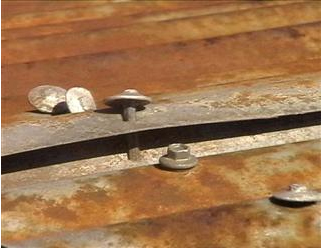
Building inspection reveals roof is in poor condition and requires complete replacement.

Building inspection reveals cracking in garage wall due to expansion in metal lintel
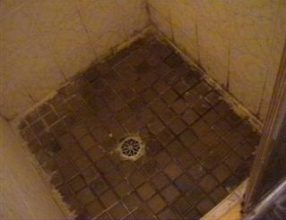
Shower recess is in poor condition and requires complete replacement. The recess is leaking water under the house and has attracted termites (the termites have caused severe damage to the floor structure and have worked there way into the walls). Can you afford not to have a pre purchase building and pest inspection?

During the course of the inspection, our inspector open up a shed at the rear of a property and WAMO a termite nest is found. Our combined building and pest inspectors will find the nest on your next property.
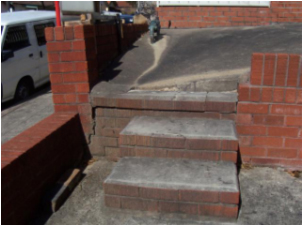
Look at the condition of the path and stairs in this strata building found during this building inspection. Such conditions pose trip/safety hazards and must be rectified.
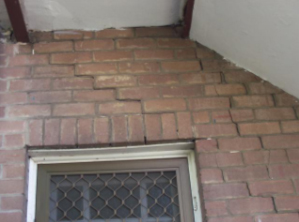
Building inspection reveals severe cracking and movement in external walls.
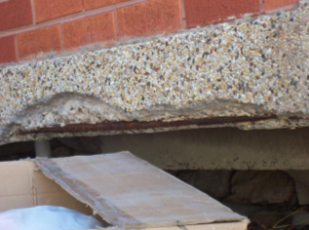
Severe concrete cancer found in the edge of slab.
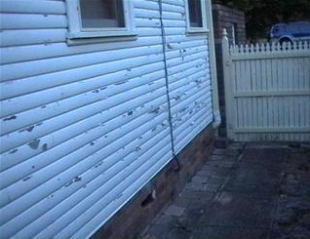
Do you think your external cladding requires repair or maintenance?

Balustrades require replacement as the gap between tailings is too wide. Your building inspector will make such recommendation.